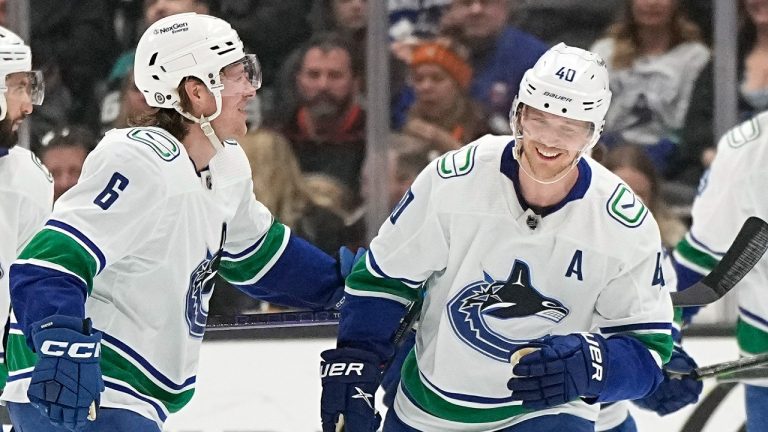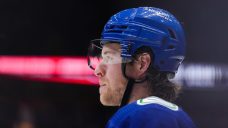VANCOUVER – Another lost season, another important summer for the Vancouver Canucks.
A year ago, the burning off-season issues facing management was its disconnect with head coach Bruce Boudreau, and looming contract extensions for J.T. Miller and Bo Horvat.
If it wasn’t wrong to keep Boudreau, it certainly was wrong not to replace him before Jan. 22. But at least new general manager Patrik Allvin eventually hired his own coach in Rick Tocchet, ending the hockey-ops dysfunction and giving the Canucks a chance to succeed. The wisdom of re-signing Miller and eventually trading Horvat will be debated for the next seven years and $56-million (Miller’s contract). Or is it eight years and $68-million? (Horvat’s deal with the New York Islanders).
In any case, priorities for Allvin this summer seem just as clear if not so seismic, although paying Elias Pettersson more than $10 million annually for eight years would be kind of a big thing.
PUSH FOR A PETTERSSON EXTENSION
Good things may come to those who wait, but the best things – and best athletes – usually cost more in time.
Pettersson probably isn’t going to be any cheaper to re-sign next year. So, unless they have any serious concerns about the player’s long-term fit in Vancouver and ability to lead the team, the Canucks should push this summer to make Pettersson the highest-paid player in franchise history.
It’s worth remembering that Pettersson wasn’t looking for a bridge deal in 2021 when he signed his current three-year contract. It was forced upon him by circumstances.
The Canucks’ salary-cap crunch had fully arrived under former GM Jim Benning, and pragmatic agents J.P. Barry and Pat Brisson knew there wasn’t long-term money available for both Pettersson and Quinn Hughes. The defenceman was always going to be less expensive to sign long term and, essentially, was a family member of the agency, which employs Jim Hughes as a development coach.
So, Hughes landed with a six-year deal at what now looks like a bargain $7.85 million per season, while Pettersson signed for half that term and $7.35 million annually.
Despite stickhandling a little on questions last weekend about his contract status a year out from restricted free agency, Pettersson presumably would still like that long-term deal – especially with his value stoked by a 102-point season.
For that reason, Allvin, who noted last week that Pettersson is still two years away from being UFA-eligible, may be more willing than people think to let the issue slide into (or after) the final season of the centre’s bridge deal.
But there is something else worth remembering. As Pettersson told HockeySverige two summers ago in Sweden before his current deal was negotiated: “I want to stay now, but I also want to play for a team that’s winning and has the chance to go far into the playoffs every year.”
Pettersson told reporters nine days ago that he still believes he has the chance to win in Vancouver. The Canucks would do well to take advantage of those feelings now.
FIND THAT THIRD-LINE CENTRE
Allvin and Tocchet agreed at their year-end press conference – see, harmony – that the No. 1 lineup need is for a third-line centre to fill the gap in the middle created when Horvat was traded.
The Canucks have a couple of internal candidates in Nils Aman, 23, and Aatu Raty, 20, the centrepiece of the Horvat trade and arguably the top prospect in the organization. And don’t sleep on Max Sasson, 22, the strong and speedy two-way centre signed as a free agent from Western Michigan University, eventually developing into that role.
But while it’s doubtful that any of these prospects will be ready next season for third-line minutes (not in the NHL, anyway), the bigger concern for the Canucks is what happens if Pettersson or Miller is injured. Who is filling in for them in the top six?
This is why Allvin will be shopping, in trade or free agency, for an experienced NHL centre to anchor the third line.
Whether it’s Max Domi, Pius Suter or Ivan Barbashev – we’re spit-balling here, but it’s worth noting Barbashev is another Dan Millstein client – a 20-something free agent will not be cheap.
PAYING FOR 3C
CapFriendly.com shows the Canucks already exceeding next season’s salary limit with $85.2 million in commitments, including injured players, so any significant contract addition will have to be accompanied by a contract subtraction.
The most inefficient contracts belong to defencemen Oliver Ekman-Larsson (four seasons remaining at $7.26 million) and Tyler Myers (one year, $6 million), who both regressed alarmingly this past season.
Ekman-Larsson revealed last week how much the broken foot he suffered at the world championships a year ago affected his summer training and mobility this season. He is determined to be faster and better next year, and Allvin made it clear the Canucks will give him that opportunity.
They haven’t much choice as the Swede’s contract is untradeable and with an eight-year payment schedule of dead money should the Canucks buy him out, the OEL poison pill would not only make the team sick but could kill it.
The Myers’ contract, by contrast, should be moveable in some form once he is paid a $5-million bonus this summer, leaving him with actual salary of only $1 million to go with his $6-million cap hit. The problem besides finding a taker for Myers, who has partial trade protection, is that the giant signing bonus isn’t payable until Sept. 15, complicating the timing of a trade.
No matter how many ways you look at potential cost-savings for the Canucks, the endeavour always seems to come back to trading either Brock Boeser (two years remaining at $6.65 million) or Conor Garland (three years at $4.95 million). Or both.
Someone has to go.
UPGRADE THE DEFENCE
We copied and pasted this heading from last year’s story, and the one from the year before, and...
Actually, the Canucks’ big off-season addition on the blue line was made in-season when Filip Hronek was acquired at the deadline. He played only four games in March before the team wisely shut him down to allow Hronek to heal his shoulder and start preparing for next season, when he should be a legitimate No. 2 defenceman in Vancouver behind Hughes.
Let’s call restricted free agent Ethan Bear a No. 4 defenceman. That still leaves a hole on the second pairing at No. 3.
Guillaume Brisebois and Christian Wolanin were rewarded with new contracts after successful callups from the AHL late in the season. Expecting more than third-pairing NHL minutes from either next fall is wishful thinking, but still more realistic than the idea that impressive college free agent Akito Hirose will be ready for even more next season when the games matter. Unless Ekman-Larsson takes a summer holiday to France and dips himself in the holy waters at Lourdes, the Canucks are still missing a second-pairing defenceman.
Oh, and go ahead and re-sign Bear.
WORK ON A PRACTICE FACILITY
We understand it’s not a big deal to anyone in charge that the Canucks are one of the few NHL organizations – possibly the only one – that does not have a media workroom for schleps covering their team. Sure, Rogers Arena is a great place to watch a game, but its footprint is small and, well, priorities.
But it should concern everyone involved that they’re also one of only two NHL franchises that does not have its own practice facility. This has always mattered more to players than ownership. But it especially matters now that Tocchet is publicly and privately imploring players to show up in Vancouver at least a month before training camp to skate together and get ready for the season.
Finding and renting ice generally isn’t a problem for players. But without dedicated medical and training facilities attached to the rink, as well as the equipment-logistics nightmare of using somebody else’s ice, how appealing is it for players to skate in August in Vancouver compared to staying with their own high-performance training groups closer to home?
President of hockey operations Jim Rutherford said a year ago that the organization was getting closer to a practice facility, but Allvin’s comments last week gave no indication progress has been made. The Canucks are a billion-dollar company. Alone or in a public-private partnership, they should be able to afford a practice rink.
AND RE-SIGN KYLE BURROUGHS
The Canucks lost some toughness and leadership when they traded defenceman Luke Schenn to Toronto at the deadline. There’s no need for them also to lose Kyle Burroughs to free agency.
The rugged blue-liner from White Rock has proven willing to do anything to help the Canucks, including fight for teammates, while showing himself capable of filling the difficult and thankless role as a depth player. The 27-year-old held his own territorially at five-on-five, finishing mid-pack on the team in shots-for (47.5 per cent) and expected-goals (49.3), led the Canucks in blocks-per-60-minutes (6.04) and was fourth in hits-per-60 (11.87) among players who logged at least 20 games. And he can fill in on both sides of defence while making entry-level money.
Everyone knows the Canucks need to upgrade their defence. But for what he costs and what he offers, Burroughs is difficult to beat at the bottom of the roster








COMMENTS
When submitting content, please abide by our submission guidelines, and avoid posting profanity, personal attacks or harassment. Should you violate our submissions guidelines, we reserve the right to remove your comments and block your account. Sportsnet reserves the right to close a story’s comment section at any time.